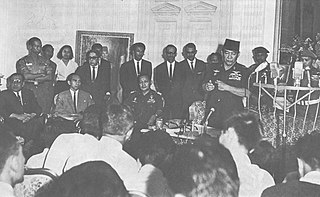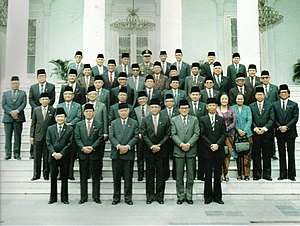
The First United Indonesia Cabinet, formerly the United Indonesia Cabinet, was the official name of the presidential cabinet of Indonesia, led by President Susilo Bambang Yudhoyono during his first period in office from 2004 until 2009. It consisted of ministers, secretaries and an attorney general. They were sworn in on 21 October 2004 for a term of office until 2009. The cabinet was reshuffled twice, on 7 December 2005 and 9 May 2007.

The Order of Eleventh March, commonly referred to by its syllabic abbreviation Supersemar, was a document signed by the Indonesian President Sukarno on 11 March 1966, giving army commander Lt. Gen. Suharto authority to take whatever measures he "deemed necessary" to restore order to the chaotic situation during the Indonesian mass killings of 1965–66. The abbreviation "Supersemar" is also a play on the name of Semar, the mystic and powerful figure who commonly appears in Javanese mythology including wayang puppet shows. The invocation of Semar was presumably intended to help draw on Javanese mythology to lend support to Suharto's legitimacy during the period of the transition of authority from Sukarno to Suharto.

The Development Reform Cabinet was the Indonesian cabinet which served under President B. J. Habibie during his term as president from 23 May 1998 to 20 October 1999.

The Seventh Development Cabinet was the Indonesian cabinet which served under President Suharto and Vice President B. J. Habibie from 16 March 1998 to 21 May 1998.

The Sixth Development Cabinet was the Indonesian cabinet which served under President Suharto and Vice President Try Sutrisno from March 1993 until March 1998. The Cabinet was formed after Suharto was elected to a 6th term as President by the People's Consultative Assembly (MPR).

The Fifth Development Cabinet was the Indonesian cabinet which served under President Suharto and Vice President Sudharmono from March 1988 until March 1993. The cabinet was formed after Suharto was elected to a 5th term as president by the People's Consultative Assembly (MPR).

The Third Development Cabinet is the name of the cabinet of the Indonesian government led by President Suharto and Vice President Adam Malik. The cabinet was announced on 29 March 1978 and served from 31 March 1978 until 16 March 1983.

The First Development Cabinet is the name of the cabinet of the Indonesian government led by President Suharto. This cabinet was announced on 6 June 1968 and served from 10 June 1968 until 27 March 1973. The composition of this cabinet is not much different from the composition of ministers in the Revised Ampera Cabinet. Shortly after the 1971 election, on 9 September 1971, President Suharto announced a reshuffle of the First Development Cabinet and appointed the reshuffled ministers on 11 September 1971.

The Revised Ampera Cabinet was an Indonesian cabinet which served under Acting President Suharto from October 1967 until June 1968. In addition to the acting presidency, Suharto was also Minister of Defense and Security in this Cabinet.

The Ampera Cabinet was the Indonesian cabinet which served under President Sukarno and later on Acting President Suharto from July 1966 until October 1967. The cabinet was formed after the Provisional People's Consultative Assembly (MPRS) session of 1966 which commissioned Suharto to form a new cabinet. Although Sukarno would not be removed from the presidency for some months, for all intents and purposes, the person who was truly in charge of the cabinet, and Indonesia by this point, was Suharto.

The Second Revised Dwikora Cabinet was the Indonesian cabinet which served under President Sukarno from March 1966 until July 1966. The cabinet was formed after Lieutenant General Suharto, using the powers that Sukarno gave to him through Supersemar, arrested 15 ministers from the Revised Dwikora Cabinet who were suspected of being sympathizers of the Indonesian Communist Party (PKI).

The National Unity Cabinet was the Indonesian cabinet which served under President Abdurrahman Wahid and Vice President Megawati Sukarnoputri from 29 October 1999 until 23 July 2001. The Cabinet was formed after Wahid and Megawati were elected President and Vice President by the People's Consultative Assembly (MPR). The cabinet was originally designed to look after the interests of the various political parties and the Indonesian National Armed Forces, but this notion quickly disappeared as Wahid's presidency began to break down.

The Revised Dwikora Cabinet was the Indonesian cabinet which served under President Sukarno from February 1966 to March 1966. The cabinet was formed under an extremely tense political situation, and it was expected that this cabinet would address the concerns of the people. It was during a meeting of this cabinet that unidentified troops surrounded the Presidential Palace causing to Sukarno to escape to Bogor from where he gave Supersemar to Lieutenant General Suharto.

The Second Working Cabinet was an Indonesian cabinet that served from 18 February 1960 until 6 March 1962, when President Sukarno reshuffled it.

The Third Working Cabinet was an Indonesian cabinet that resulted from a 6 March 1962 reshuffle of the previous cabinet by President Sukarno. It consisted of a first minister, two deputy first ministers, eight coordinating ministers, 36 ministers, as well as 13 members who headed various government bodies. It was dissolved on 13 November 1963.

The Fourth Working Cabinet was an Indonesian cabinet that resulted from regrouping of the previous cabinet by President Sukarno. It consisted of three deputy prime ministers, eight coordinating ministers, 33 ministers, six ministers of state, as well as 11 cabinet members who headed various government bodies. It was dissolved on 27 August 1964.

The Dwikora Cabinet was the 23rd Indonesian cabinet. President Sukarno reshuffled the previous cabinet on 27 August 1964 to produce a cabinet better able to implement the government policy he had announced in his Independence Day speech entitled "The Year of Living Dangerously". The cabinet was appointed on 2 September and served for a year and five months before being reshuffled on 21 February 1966.

Brigadier General Raden Panji Nugroho Notosusanto was an Indonesian short story writer turned military historian who served as a professor of history at the University of Indonesia. Born to a noble family in Central Java, he exhibited a high degree of nationalism from a young age. During the Indonesian National Revolution from 1945 to 1949, he saw active service as a member of the Student Army, working reconnaissance. Despite wanting to remain in the military, under the influence of his father he continued his education, eventually enrolling in the faculty of literature at the University of Indonesia. During the 1950s he wrote extensively and was active in numerous political and academic groups, finally graduating with a degree in history in 1958.

Johannes Baptista Sumarlin was an Indonesian economist who served as Minister of Finance. Sometimes linked with the so-called Berkeley Mafia group of economic advisers which included senior Indonesian economists such as Widjojo Nitisastro, Emil Salim, and Ali Wardhana, Sumarlin held various important economics posts in the Indonesian government for many years until the late 1990s. He graduated from the Faculty of Economics, University of Indonesia (FEUI) in 1958. Positions held in government included, among others, Chairman of the Supreme Audit Agency, Minister of Finance, Chairman of the National Planning Agency (Bappenas), and Minister for Administrative and Bureaucratic Reform.

The First Working Cabinet was an Indonesian cabinet that served from 10 July 1959 until 18 February 1960, when President Sukarno reshuffled it.




















